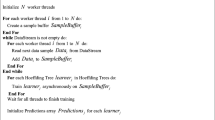Abstract
The overwhelming flood of data in intensive care medicine precludes consistent judgement of medical interventions by humans. Therefore, computerized decision support is needed to assist the health care professional in making reproducible, high-quality decisions at the bedside. Traditional expert systems rely on a tedious, labor-intensive and time-consuming approach in their development which falls short of exploiting existing numerical and qualitative data in large medical databases. Therefore, we applied a new concept of combining time series analysis and a knowledge base system with learning and revision capabilities (MOBAL) for rapid development of decision support algorithms for hemodynamic management of the critically ill. This approach could be successfully implemented in an existing intensive care database handling time-oriented data to validate and refine the intervention rules. The generation of hypotheses for identified contradictions lead to conclusive medical explanations that helped to further refine the knowledge base. This approach will provide for a more efficient and timely development of decision support algorithms.
Preview
Unable to display preview. Download preview PDF.
Similar content being viewed by others
References
Bauer M, Gather U, Imhoff M (in print): Analysis of high dimensional data from intensive care medicine. In: Payne R. (ed) Proceeding in Computatinal Statistics, Springer-Verlag, Berlin
Guyatt G, Drummund M, Feeny D, Tugwell P, Stoddart G, Haynes R, Bennett K, LaBelle R (1986): Guidelines for the clinical and economic evaluation of health care technologies. Soc Sci Med 22: 393–408.
Imho_ M (1995): A clinical information system on the intensive care unit: dream or night mare? In: Rubi J. A. G.: Medicina Intensiva 1995, XXX. Congreso SEMIUC. Murcia, 4.–6.10.1995
Imho_ M (1996): 3 years clinical use of the Siemens Emtek System 2000: Efforts and Benefits. Clinical Intensive Care 7 (Suppl.): 43–44
Imho_ M (1998): Clinical Data Acquisition: What and how? Journal für Anästhesie und Intensivmedizin 5: 85–86
Imho_ M, Bauer M, Gather U, Löhlein D (1998): Statistical pattern detection in univariate time series of intensive care on-line monitoring data. Intensive Care Med 24: 1305–1314
Imho_ M, Bauer M, Gather U (submitted): Time-effect relations of medical interventions in a clinical information system. KI-99, Bonn 13.–15.05.99
Imho_ M, Lehner JH, Löhlein D (1994): 2 years clinical experience with a clinical information system on a surgical ICU. In: Mutz N. J., Koller W., Benzer H.: 7th European Congress on Intensive Care Medicine. Monduzi Editore, Bologna. S. 163–166
Isham V (1993): Statistical aspects of chaos: a review. In: Barndorff-Nielsen OE, Jensen WS, Kendall WS (eds) Networks and Chaos-Statistical and Probabilistic Aspects. Chapman and Hall, London, pp 251–300
Jennings D, Amabile T, Ross L (1982): Informal covariation assessments: Databased versus theory-based judgements. In: Kahnemann D, Slovic P, Tversky A, editors. Judgement under uncertainty: Heuristics and biases. Cambridge: Cambridge University Press: 211–230.
McDonald JM, Brossette S, Moser SA (1998): Pathology information systems: data mining leads to knowledge discovery. Arch Pathol Lab Med 122: 409–411
Miller G (1956): The magical number seven, plus of minus two: Some limits to our capacity for processing information. Psychol Rev 63: 81–97
Morik K, Brockhausen P (1997): A multistrategy approach to relational knowledge discovery in databases. Machine Learning Journal 27: 287–312
Morik K, Brockhausen P, Joachims T (1999): Combining statistical learning with a knowledge-based approach-A case study in intensive care monitoring. In: Procs. Int. Conf. Machine Learning (in print).
Morik K, Wrobel S, Kietz JU, Emde W(1993): Knowledge acquisition and machine learning-Theory, methods, and applications. Academic Press, London
Morris A, Gardner R (1992): Computer applications. In: Hall J, Schmidt G, Wood L, editors. Principles of Critical Care. New York: McGraw-Hill Book Company: 500–14
Packard NH, Crutchfield JP, Farmer JD, Shaw RS (1980): Geometry from a time series. Phys Rev Lett 45: 712–716
Soo VW, Wang JS, Wang SP (1994): Learning and discovery from a clinical database: an incremental concept formation approach. Artif Intell Med 6: 249–261
Takens F (1980): Detecting strange attractors in turbulence. In: Rand DA, Young LS (eds) Dynamical systems and turbulence. Lecture Notes in Mathematics Vol. 898 Springer, Berlin, pp 366–381
Thomsen GE, Pope D, East TD, Morris AH, Kinder AT, Carlson DA, Smith GL, Wallace CJ, Orme JF Jr, Clemmer TP, et al. (1993): Clinical performance of a rulebased decision support system for mechanical ventilation in ARDS patients. Proc Annu Symp Comput Appl Med Care: 339–343
Tong H (1995): A personal overview of non-linear time series analysis from a chaos perspective, Scand J Statist 22: 399–445
Tsumoto S, Ziarko W, Shan N, Tanaka H (1995): Knowledge discovery in clinical databases based on variable precision rough set model. Proc Annu Symp Comput Appl Med Care 1995: 270–274
da Veiga FA (1996): Structure discovery in medical databases: a conceptual clustering approach. Artif Intell Med 8: 473–491
Wrobel S (1994): Concept formation and knowledge revision. Kluwer Academic Publishers, Dordrecht
Author information
Authors and Affiliations
Editor information
Editors and Affiliations
Rights and permissions
Copyright information
© 1999 Springer-Verlag Berlin Heidelberg
About this paper
Cite this paper
Imhoff, M., Gather, U., Morik, K. (1999). Development of Decision Support Algorithms for Intensive Care Medicine: A New Approach Combining Time Series Analysis and a Knowledge Base System with Learning and Revision Capabilities. In: Burgard, W., Cremers, A.B., Cristaller, T. (eds) KI-99: Advances in Artificial Intelligence. KI 1999. Lecture Notes in Computer Science(), vol 1701. Springer, Berlin, Heidelberg. https://doi.org/10.1007/3-540-48238-5_18
Download citation
DOI: https://doi.org/10.1007/3-540-48238-5_18
Published:
Publisher Name: Springer, Berlin, Heidelberg
Print ISBN: 978-3-540-66495-6
Online ISBN: 978-3-540-48238-3
eBook Packages: Springer Book Archive




